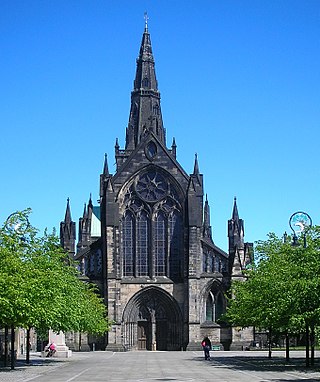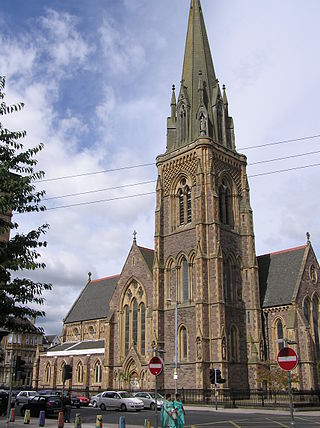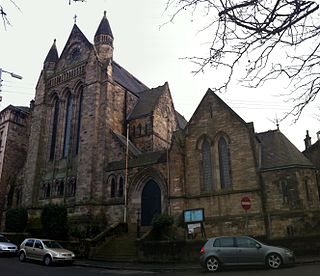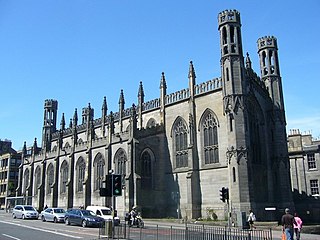The Scottish Episcopal Church is the ecclesiastical province of the Anglican Communion in Scotland.

Brechin is a town and former Royal burgh in Angus, Scotland. Traditionally Brechin was described as a city because of its cathedral and its status as the seat of a pre-Reformation Roman Catholic diocese, but that status has not been officially recognised in the modern era.

Glasgow Cathedral is a parish church of the Church of Scotland in Glasgow, Scotland. It is the oldest cathedral in mainland Scotland and the oldest building in Glasgow. The cathedral was the seat of the Archbishop of Glasgow, and the mother church of the Archdiocese of Glasgow and the Province of Glasgow, until the Scottish Reformation in the 16th century. Glasgow Cathedral and St Magnus Cathedral in Orkney are the only medieval cathedrals in Scotland to have survived the Reformation virtually intact. The medieval Bishop's Castle stood to the west of the cathedral until 1789.

The Cathedral Church of St Mary the Virgin, commonly called St Mary's Cathedral, is a cathedral of the Scottish Episcopal Church. It is located on the Great Western Road, in the west end of Glasgow, Scotland. The current building was opened on 9 November 1871 as St Mary's Episcopal Church and was completed in 1893 when the spire was completed. The architect was Sir Gilbert Scott. It was raised to cathedral status in 1908. The total height of the cathedral is 63 metres. The church structure is protected as a category A listed building.

The Metropolitan Cathedral Church of Saint Andrew or Glasgow Metropolitan Cathedral is a Roman Catholic Cathedral in the city centre of Glasgow, Scotland. It is the mother church of the Roman Catholic Archdiocese of Glasgow. The cathedral, which was designed in 1814 by James Gillespie Graham in the Neo Gothic style, lies on the north bank of the River Clyde in Clyde Street. St Andrew's Cathedral is the seat of the Archbishop of Glasgow, currently William Nolan. It is dedicated to the patron saint of Scotland, Saint Andrew.
The Nonjuring schism refers to a split in the established churches of England, Scotland and Ireland, following the deposition and exile of James II and VII in the 1688 Glorious Revolution. As a condition of office, clergy were required to swear allegiance to the ruling monarch; for various reasons, some refused to take the oath to his successors William III and II and Mary II. These individuals were referred to as Non-juring, from the Latin verb iūrō, or jūrō, meaning "to swear an oath".

St. Luke's Greek Orthodox Cathedral is a cathedral of the Greek Orthodox Church in the Dowanhill district of Glasgow, Scotland.
The Bishop of Edinburgh, or sometimes the Lord Bishop of Edinburgh, is the ordinary of the Scottish Episcopal Diocese of Edinburgh.

The Cathedral Church of Saint Mary the Virgin, commonly known as St Mary's Episcopal Cathedral, is a cathedral of the Scottish Episcopal Church in Edinburgh, Scotland; part of the worldwide Anglican Communion active in many countries around the world. Its foundation stone was laid in Palmerston Place, in the city's West End, on 21 May 1874 by the Duke of Buccleuch and Queensberry, and the building was consecrated on 30 October 1879.

St Paul's and St George's Church is an evangelical church of the Scottish Episcopal Church in central Edinburgh, Scotland. It is located on the corner of Broughton Street and York Place in the east end of Edinburgh's New Town, and is protected as a category A listed building.

Reverend John Comper (1823–1903) was a Priest of the Episcopal Church in Scotland who dedicated his life to helping the street children and prostitutes of Victorian Aberdeen. In 2003 Father Comper was declared a 'Hero of the Faith' by the Scottish Episcopal Church – the equivalent of a saint and the greatest honour the Church can bestow. In the Calendar of the Scottish Episcopal Church he is remembered on 27 July, the day of his death.

Old Saint Paul's is an historic church of the Scottish Episcopal Church in the heart of Edinburgh's Old Town in Scotland. It is one of the original congregations of the Scottish Episcopal Church, part of the Anglican Communion, which evolved with the adoption of Presbyterian governance by the established Church of Scotland.
The history of the Scottish Episcopal Church is traced by the church to ancient times. The Church today is a Christian denomination in Scotland and a member of the Anglican Communion. It has enjoyed a distinct identity and is neither Roman nor English. It is therefore not a Daughter Church in the Anglican communion.
Alexander Duncan (c.1655–1733) was a non-jurant Scottish Episcopal clergyman, college bishop, and Bishop of Glasgow from 1731.

John Snetzler was an organ builder of Swiss origin, who worked mostly in England. Born in Schaffhausen in 1710, he trained with the firm of Egedacher in Passau and came to London about 1741. When he retired in 1781, his business continued and ended up with Thomas Elliot. Snetzler died in Schaffhausen on 28 September 1785.
Andrew Macdonald (1757–1790), pen name Matthew Bramble, was a Scottish clergyman, poet and playwright.

The Church of St Mary the Virgin is a Scottish Episcopal Church, in Arbroath, Angus, Scotland. It is part of the Diocese of Brechin.

A Qualified Chapel, in eighteenth- and nineteenth-century Scotland, was an Episcopal congregation that worshipped liturgically but accepted the Hanoverian monarchy and thereby "qualified" under the Scottish Episcopalians Act 1711 for exemption from the penal laws against the Episcopal Church of Scotland.

Church music in Scotland includes all musical composition and performance of music in the context of Christian worship in Scotland, from the beginnings of Christianisation in the fifth century, to the present day. The sources for Scottish Medieval music are extremely limited due to factors including a turbulent political history, the destructive practices of the Scottish Reformation, the climate and the relatively late arrival of music printing. In the early Middle Ages, ecclesiastical music was dominated by monophonic plainchant, which led to the development of a distinct form of liturgical Celtic chant. It was superseded from the eleventh century by more complex Gregorian chant. In the High Middle Ages, the need for large numbers of singing priests to fulfill the obligations of church services led to the foundation of a system of song schools, to train boys as choristers and priests. From the thirteenth century, Scottish church music was increasingly influenced by continental developments. Monophony was replaced from the fourteenth century by the Ars Nova consisting of complex polyphony. Survivals of works from the first half of the sixteenth century indicate the quality and scope of music that was undertaken at the end of the Medieval period. The outstanding Scottish composer of the first half of the sixteenth century was Robert Carver, who produced complex polyphonic music.















